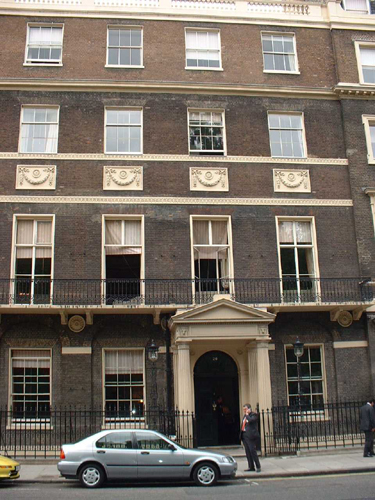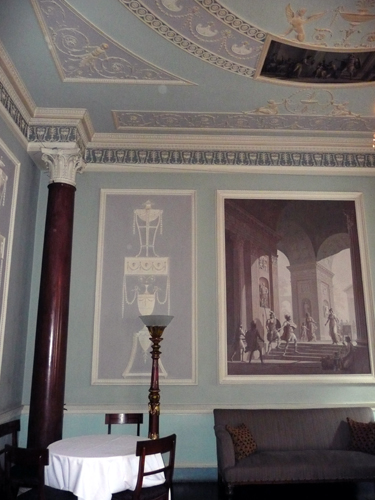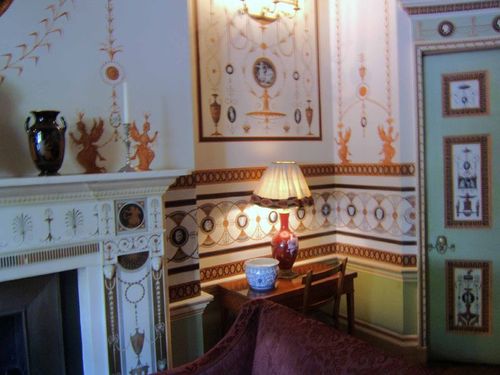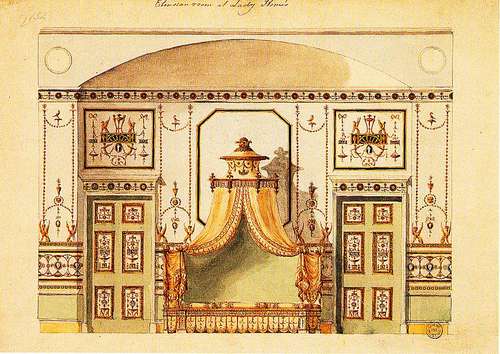
Home House was completed in 1778 to the designs (initially) of James Wyatt and (later) Robert Adam.
The building changed hands many times over the years. Later occupants included the Marquis de la Luzerne during his time as French ambassador to the Court of St. James’s (1788 to 1791), the 4th Duke of Atholl (1798 to 1808). Charles, 2nd Earl Grey was the tenant from 1812-19. Alterations carried out during this period included the addition of an extra storey, ca.1813. The house was empty for half of 1819. The 4th Duke of Newcastle occupied the building from 1820 to 1851 and he was followed by Sir Francis Henry Goldsmid (1862 to 1919), and Lord and Lady Islington (1919 to 1926). The Islington alterations included the installation of bathrooms on the second and third floors; the hanging of eighteenth century Chinese wallpaper in the blue bedroom; and the forming of a garden door and steps in the North wall of the mews.
In 1926 the house was leased by the art-collector Samuel Courtauld who leased it to house his growing collection. On his wife’s death in 1931, he gave the house and the collection to the fledgling Courtauld Institute of Art (which he had played a major part in founding), to house it until it could find better accommodation. That accommodation was not forthcoming, and the Institute remained in the building until 1989, when it moved to its present home of Somerset House.
Having been empty for seven years it became a private members’ club.

I was commissioned to carry out the paint analysis of a number of surfaces, both internal and external.

It appears that the exterior of 20 Portman Square was painted at intervals of about four years from 1773 to 1985. This has been one of the most frequently painted external surfaces that I have encountered, matched only by a house in Queen Anne’s Gate, Westminster (see recent blog).

I have also carried out a colour survey of the building and has matched all the paint colours, which my company Papers and Paints now provide for maintenance purposes.

Another project on a Courtauld residence was at Eltham Palace.
View Larger Map












[...] Colour Match of a stippled surface in Wilton House As many will know, Papers and Paints have been colour-matching objects brought to the shop for most of our fifty years. Typically these take the form of flakes of paint and pieces of wallpaper or fabric. However, what happens if you cannot bring the colour to be matched to us? Since the early 1990s we have offered a unique colour service – we can come to your own premises and measure the wall, curtains or whatever it is that you want matched with a portable spectrophotometer. It may be that an area of localised damage needs to be painted to match the colour on the surrounding wall. Perhaps the room is too large, and time and money insufficient to permit a complete repaint. The paint could be from a discontinued or unknown source. Cost-effective in-painting is made possible by measuring the paint, and producing a new tin that matches the original under all lighting conditions. Measuring Paint Colours in a London Club Equally, it may be more than one colour that you want matched. You might be responsible for the maintenance of a building where the records are out of date and have no idea which of the old tins that you have been left relate to the colours on the walls. We can deal with the problem by carrying out a colour survey. Lancaster House Even the best run establishments lose track of what colours have been used, but either see no reason to change the existing scheme of decoration, or want to rationalise it. Umpteen variations of off-white were identified at Lancaster House, for example, and it was decided that this was causing too much confusion for the maintenance programme. After an hour-long survey, each colour was identified, and a proposal made for the gradual reintroduction of a single colour. Spencer House On-site colour surveys have been carried out for various reasons elsewhere. At Spencer House, and No 1 Greek Street, the colours produced as part of recent restoration projects were measured in order to facilitate redecoration. In both instances, the paint had originally been mixed up in buckets under the supervision of consultants. Needless to say, as a result, touching-in had proved difficult as nothing seemed to match. Colour measurement allows for the identification and formulation of a paint colour, minimising delays and costs. Syon House – Great Hall In an attempt to give greater articulation to the architecture, John Fowler had introduced a number of colours in the Entrance Hall at Syon House. Twenty five years later possible options for redecoration were being considered. One school of thought felt that there was no reason to change the Fowler scheme. Once again, a survey identified these colours and a seamless redecoration, using the same colours, could have been carried out if required. Martin Measures the Wall in the Orangery at Kensington Palace Occasionally, there is no wish to carry out redecoration, and a survey is requested as part of a condition report. This sort of work was undertaken at Newhailes, in East Lothian, for example. Although there was no intention to overpaint large areas of surviving eighteenth and nineteenth century paint, it was thought important to record how the rooms looked. Newhailes We do a lot of work in clubland, in institutions where the fine line between minimum change and good maintenance tends to be observed. In one club, members had grown used to the nicotine-stained ceiling of the Cocktail Bar. The Secretary, however, wanted to tidy up the room without upsetting any sensibilities. Colour measurements were taken, and paint produced to match the average colour reading of the stained ceiling. Measuring the Nicotine-Sained Ceiling in a London Club We have carried out colour surveys in a number of the best known clubs in St James’s. A schedule is produced and when paint is required for maintenance it can be ordered in the knowledge that it will match the existing colours. The following image shows a typical page from one of these schedules: A Page from a Typical Colour Schedule In the famous Painted Hall of the former Royal Naval College, at Greenwich we were asked to provide a better colour than the existing one for the dado / lower wall. Our approach was to take a series of measurements from the James Thornhill painted walls and to aggregate the colours into types i.e. dark, medium, light, brown, green. Paints were then produced to match each of the “types” and colour trials made. The result is a colour that best approximates the mass tone of the walls above. The photograph below shows the Painted Hall before the work and the completed work can be seen in this 360° panorama. Royal Naval College, Greenwich – Painted Hall Spectrophotometry can also be used for camouflage purposes, and colour matches made to many natural finishes. By taking several measurements of a Portland stone façade, for example, the average colour can be found and produced in the form of a masonry paint for the render of a new extension, or for the gate piers of Apsley House, as seen here for example. Apsley House – Measuring Gate Pier Some years ago Patrick was commissioned to carry out a series of measurements of a representative selection of the stone facades in the City of Bath. These have been added to an already enormous collection of readings that we store for future use. Measuring Colours In the field of architectural colour, once again, Papers and Paints has led the way. Here are some images from recent colour-measuring projects: Measuring colour in 575 Wandsworth Road Colour measurement in St James’s, Clerkenwell Colour measurement in Home House [...]